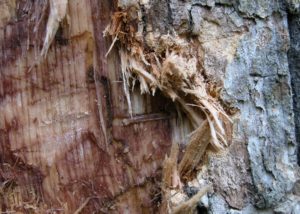By Mike Hillstrom, forest health specialist, Fitchburg, Michael.Hillstrom@wisconsin.gov, 608-513-7690
2019 was the wettest year ever recorded in Wisconsin. Four of Wisconsin’s top five wettest years have taken place in the last decade, three of them in the last five years: 2019, 2018 and 2016. Flooding can be stressful for trees, and with flooding occurring over the past few years in many parts of the state, forest health staff expect the impacts to forests to continue to escalate.
Forest health specialists have already seen direct mortality of trees from flooding along lakes and rivers and in seasonally flooded areas that have now been flooded for several consecutive years. Now flood-stressed trees in some areas are being attacked by insects.
Two-lined chestnut borer, Agrilus bilineatus, is a common native pest of oaks that has recently begun attacking flood-stressed oaks in some areas. Previous TLCB outbreaks in Wisconsin have occurred after severe gypsy moth defoliation and the 2012-2013 drought.

A two-lined chestnut borer larva tunnels underneath the bark of a stressed oak tree.
TLCB is closely related to the native bronze birch borer and damage is very similar. Larvae feed under the bark and destroy the cambium, girdling branches and sometimes the entire tree. Adult beetles also produce D-shaped exit holes when they exit from beneath the bark. The most obvious sign of TLCB infestation is branch dieback that starts in the upper canopy.
TLCB is difficult to manage in stressed forests. Salvage harvesting may help reduce economic impacts but is not effective at stopping TLCB outbreaks. Management activities like thinning should be avoided for a few years until stressed oaks have recovered. TLCB-infested trees are also frequently attacked by Armillaria root disease.
For more information, see UW-Extension publications about TLCB and oak disorders and the Minnesota DNR’s TLCB webpage.
